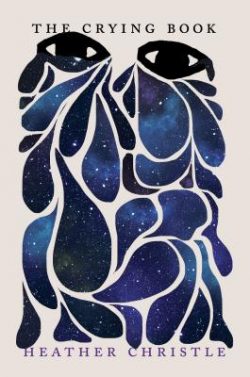For five years, Heather Christle embarks on an experiment, documenting and mapping each time she cries. This experiment, when shared with others, leads Christle to conversations with friends, to research, to her past, and ultimately to her debut nonfiction collection, The Crying Book. As a self-coined highly sensitive person, I was drawn in immediately.
Her book, a segmented, meditative lyric essay, is a compilation of observations about crying. In her first meditation, she discusses how crying in public is a way to feel seen. A page later, she complicates her own experience with research, stating that crying in public often leads to “a worsening mood. You can be made to feel ashamed.” And yet, she continues, “criers report others responding with compassion, or what the study categorizes as ‘comfort words, comfort arms, and understanding.” Early on, she shows how complex the process of pain and crying can be.
The form of the lyric essay allows Christle to accumulate a large quantity of material. Much of her book is focused in research, including but not limited to: psychologists, philosophers, and research studies; other writers and artists interrogating pain; politics and social movements; gender and racial inequalities; and murder, suicide, and death.
Reading a lyric essay collection can often feel like a light whiplash, taking hard turns into seemingly unrelated topics. The build Christle organizes feels unending, encompassing so many crying-related topics. She touches on an almost exhausting number of examples, reminding me of how exhausting it is to feel such deep emotions.
Christle writes about how tragic events, like the suicide of her friend, lead to despair and crying, showing how our emotions are often a response to the world around us. However, she also suggests that our emotions, when unable to be expressed, can be catalytic, and lead to violence. She writes: “They say perhaps we cry when language fails, when words can no longer adequately convey our hurt. When my crying is not wordless enough I beat my head with my fists.” Violence, onto the self, and to others, becomes a large theme present in her work. Christle balances research and narrative, sometimes simultaneously, to answer the question, Why? She continually interrogates, attempting to answer why she feels the way she does, why people take their lives, why people commit acts of violence, and more. She discusses Kent State, shows us a picture of a young woman “kneel[ing] beside the body of a slain student, her whole body an anguished question,” – Why?
The way Christle weaves social issues and politics into her own narrative shows a universal hurting, and how powerless we can feel to violence. Through recognizing her own pain and digging into research, Christle has found a whole world, a history of people who have endured suffering.
Kaveh Akbar, in his blurb of Christle’s work, suggests that The Crying Book is “about crying, yes, but secretly it’s a book about everything: pain, sleep, joy, despair, birth, art, exile, atrocity, language, weather, fish.” I am in awe of the multitudes this book contains. Christle addresses many topics, and yet her voice is constantly focused and microscopic. She spans centuries of history, but readers will never feel lost in time.
Amidst the amount of research Christle compiles, the book is anchored by her own narrative, following the five-year timeline of her child, beginning with conception. While motherhood is only one of many themes in her book, Christle has created a subtle way to keep readers grounded in a form that can often be difficult to follow.
The ability to jump from topic to topic requires trust in the reader that we will follow, and delicate attention to organization from the writer. The lyric essay, Christle’s especially, reminds me of the video game, Katamari Damacy, where players roll a sticky ball over random objects, growing and growing until it takes on the size of a planet. It’s a snowball effect – she collects research and stories, places them next to one another, and builds them into something whole.
Since reading Christle’s book, I have been fixated on her opening pages, which seem to resonate even louder the longer I’m away from it. I think of her opening pages when I read the news, when a friend confides in me, when I accidentally step on my dog’s tail. Crying is a reflection of our pain. And our pain, when not treated properly, can lead to violence. However, our pain, when shared, can be even more powerful. It can become a bridge, leading us to compassion, to comfort words, comfort arms, and understanding.

Heather Christle. The Crying Book. New York, NY: Catapult, 2019. 208pp. $16.95, paper.
